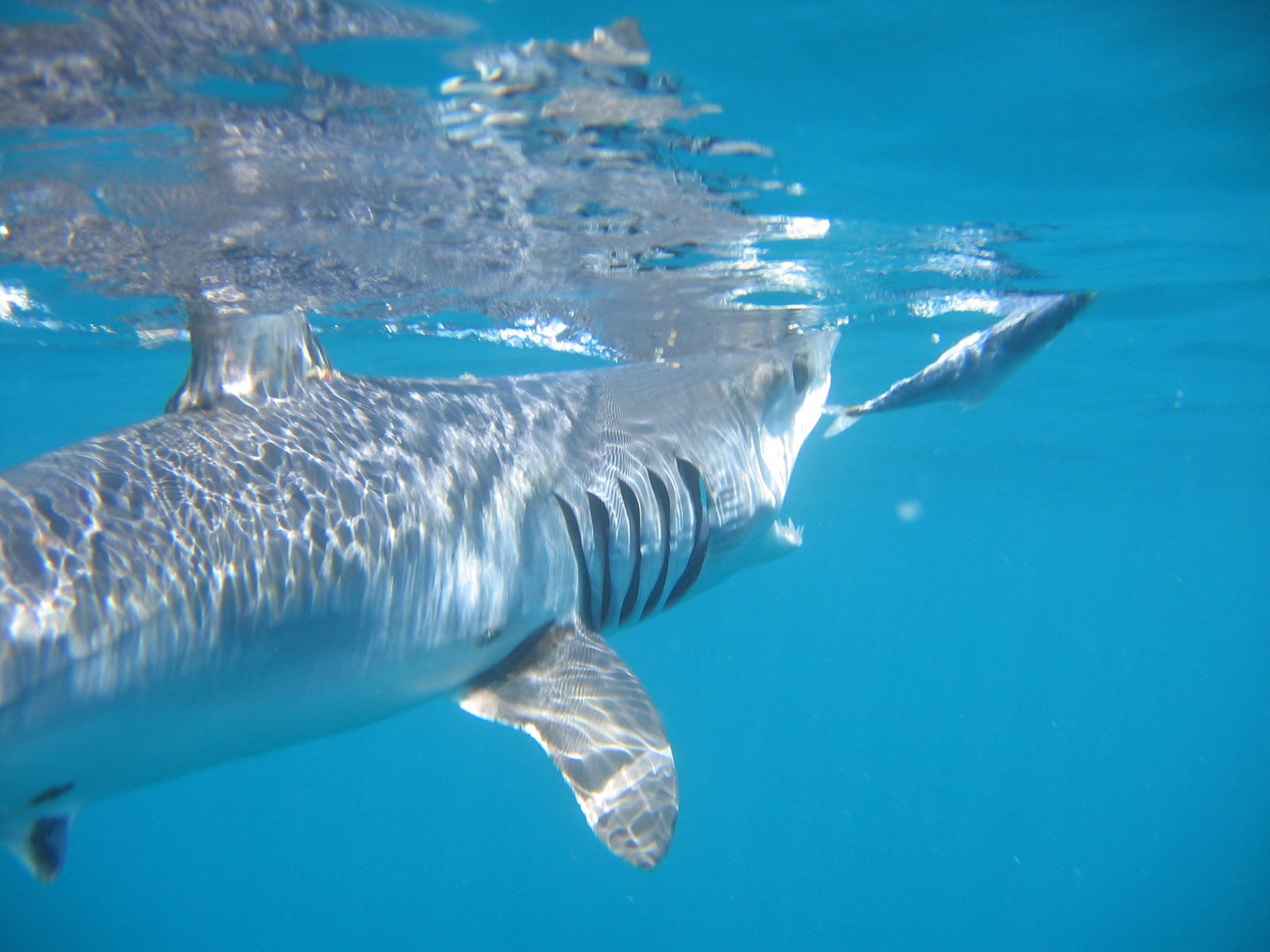Shortfin Mako, Isurus oxyrinchus Rafinesque, 1810
Blue Pointer, Mackerel Shark, Mako, Mako Shark, Snapper Shark
Introduction
The Shortfin Mako is believed to be the fastest of all sharks and can be found worldwide in tropical and temperate waters. Despite being primarily an oceanic species, it is considered to be dangerous to people.
What do Shortfin Makos look like?
Identification
The Shortfin Mako has a pointed snout and long, slender teeth that protrude from the mouth. The second dorsal and anal fins are small and the caudal fin is lunate. There is a single keel on the caudal peduncle.
The upper surface of the body is indigo blue, abruptly changing to lighter blue on the sides and white below.
Shortfin Makos can be distinguished from White Sharks by several characters. The teeth in the upper jaw are smooth-edged and slender, whereas those of the White Shark are flattened, serrated and triangular (although narrower in juveniles). The colouration of the Shortfin Mako (see above), differs from the White shark, which is blue-grey, grey-brown or bronze above with an abrupt change of colour to white below.
Where do Shortfin Makos live?
Habitat
The species occurs primarily in tropical waters (above 16 degrees Centigrade), but is known from both tropical and temperate waters circumglobally. It is found in both inshore seasonally and in continental waters from the surface to depths of at least 150 m.

© CC BY-NC 4.0
Distribution
The species occurs worldwide in tropical and temperate waters from 50oN to 50oS. In Australia it is recorded from the marine waters of all States, but has not been caught in the Northern Territory.
The map below shows the Australian distribution of the species based on public sightings and specimens in Australian Museums. Source: Atlas of Living Australia.
What do Shortfin Makos eat?
Feeding and diet
Dietary items include mainly bony fishes and cephalopods. Large individuals over 3m in length are known to take larger prey such as billfishes and small cetaceans.
Sharks online publication
Delve into the world of Sharks and explore the digital publication with videos and extra content from the exhibition. Hear from First Nations peoples, scientists and conservationists as they share their stories about these ancient survivors.
Explore nowHow have Shortfin Makos adapted and what is their life cycle?
Behaviours and adaptations
The Shortfin Mako is believed to be the fastest of all sharks. Like other lamnid sharks, it has a heat exchange circulatory system that enables the body to be warmer than the surrounding water and thus maintain a high level of activity. When hooked, the Shortfin Mako can make spectacular leaps out of the water.
Life history
Shorfin Mako Sharks are born between 60-70cm and grow to ~400 cm TL. Female mature at about 280 cm TL and 18 years of age, while males mature at 195cm TL and about 8 years.
Shortfin Mako embryo’s are oophagous, where the embryo’s eat unfertilised eggs while in the female. Females generally give birth to litters of between 2-25 pups after a gestation period of 5-18months. In New South Wales, pups are generally born in November

© N. Wegner
Are Shortfin Makos dangerous?
Danger to humans
The Shortfin Mako has been known to attack boats and injure fishers after being hooked. Despite being primarily an oceanic species, it is considered to be dangerous to people. It has been implicated in both fatal and nonfatal attacks on humans.
References
- Allen, G.R. 1997. Marine Fishes of Tropical Australia and South-east Asia. Western Australian Museum. Pp. 292.
- Hoese, D.F., Bray, D.J., Paxton, J.R. & G.R. Allen. 2006. Fishes. In Beesley, P.L. & A. Wells. (eds) Zoological Catalogue of Australia. Volume 35. ABRS & CSIRO Publishing: Australia. parts 1-3, Pp. 1-2178.
- Hutchins, B. & R. Swainston. 1986. Sea Fishes of Southern Australia. Complete Field Guide for Anglers and Divers. Swainston Publishing. Pp. 180.
- Last, P.R. & J.D. Stevens. 2009. Sharks and Rays of Australia. Edition 2. CSIRO. Pp. 644, Pl. 1-91.
- Randall, J.E., Allen, G.R. & R.C. Steene. 1997. Fishes of the Great Barrier Reef and Coral Sea. Crawford House Press. Pp. 557.
- Stevens, J.D. in Gomon, M.F., Glover, C.J.M. & R.H. Kuiter (Eds). 1994. The Fishes of Australia's South Coast. State Print, Adelaide. Pp. 992.





